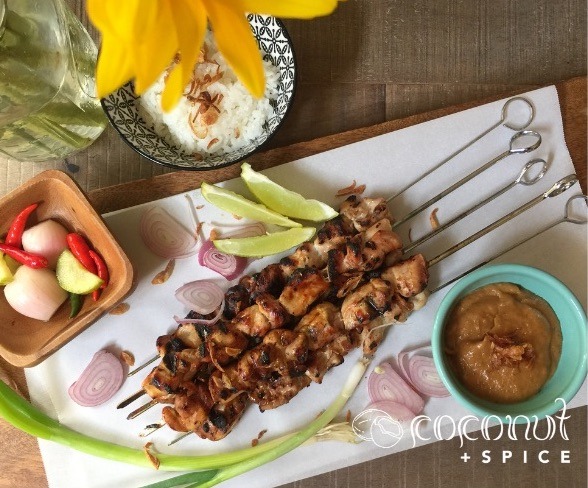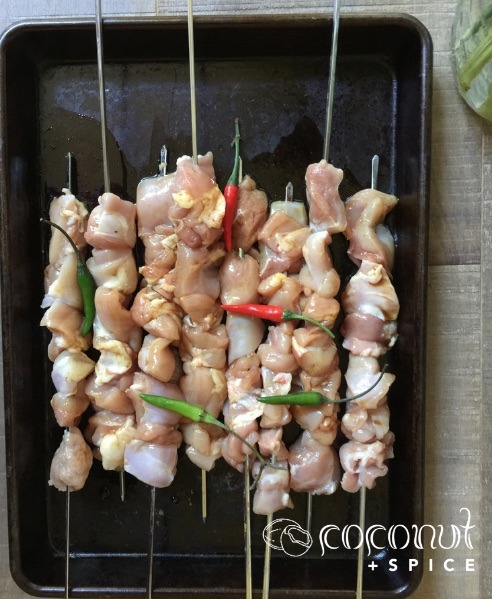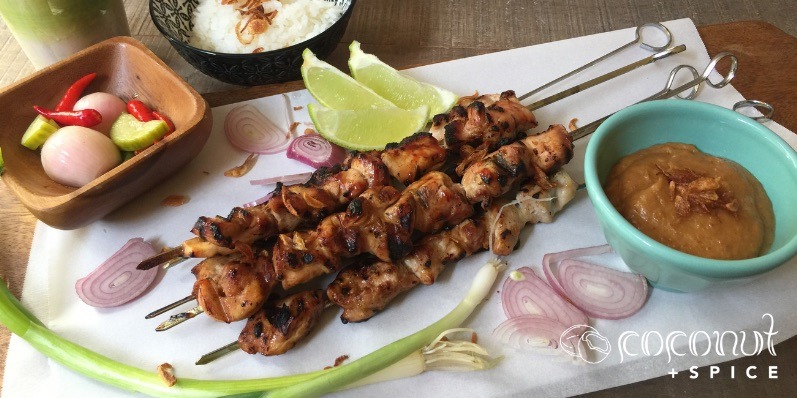This is a recipe for skewered, tender, marinated-chicken pieces grilled to perfection and served with a rich, flavorful, lime-infused spicy peanut sauce. No wonder this dish is popular throughout Southeast Asia!
In my earlier post on nasi goreng, I
In fact, besides nasi goreng, there are 4 other dishes that were chosen by the Indonesian Ministry of Tourism and Creative Economy in 2018. Guess what? Sate Ayam (Chicken Satay) also made the list.
I’m not surprised by

WHAT IS SATE (SATAY)
Sate or Satay is loosely referred to a dish of marinated meat, skewered and cooked over a charcoal grill and serve with a sauce. I included “loosely” in the
- The meat can vary from chicken, goat, pork, beef, seafood as well as organs (pork’s liver or intestine. Don’t make faces…they taste delicious when grilled). I’ve even consumed rabbit satay when I was young while traveling through East Java with family, and yes, it tasted like chicken.
- The variety of sauces and marinades/
bumbu (spices) are as diverse as Indonesia’s many cultures. I may be exaggerating a bit, but you get the idea.
In Indonesia, a special grill is used to cook sate. It has a long rectangular shape with the width just enough to hold the length of the part where the meat is threaded. I think this is the main reason the bamboo skewer is
The bare part of the bamboo skewer is safe from fire, unlike if you were to use a regular American grill. Honestly, it does not matter how long I’ve soaked the bamboo in water, a portion of the skewer always ends up getting burnt, unless l wrap the skewers with foil.
MY INDO SATE AYAM MEMORIES
Breakfast Sate
My parents have a go-to place which is just around the corner from their house. When we go for a visit, my mom always orders some the night we arrive for our first “at-home” breakfast
Bali Trips
Another story that is fresh in my mind comes from one of my trips to Bali years ago. We were driving through traffic from Ubud to our next destination, Tanah Lot. There were plenty of stops and the trip took hours, mostly due to the horrendous traffic.
We were headed to the hotel for a couple of nights of relaxation and to play golf at one of the most scenic courses in Bali, designed by Greg Norman.
I remember we were exhausted and hungry from the excursion but did not feel like ordering room service. Luckily my sister and her husband volunteered to look for take-out. And they scored big!
They brought back Sate Ayam wrapped in banana leaves packages. Not only did it look appetizing,
SATE AYAM RECIPE: PREPARATION TIPS

Don’t let it fool you, satay is a dish that looks and tastes complex, yet it’s easy to make at home especially if you enjoy cubing and skewering. There are a few tips I’d like to share with my sate
- In Indonesia, they cut the meat into very small pieces. To save time, I cut mine larger, but you can do whatever size you prefer. If you have all the time in the world, go for it, make them smaller. Just remember the smaller the pieces, the faster they cook.
- The recipe calls for dark meat which is what Indonesian prefer. It tends to result in a juicier and more tender satay. Alternatively, feel free to use chicken breast too.
- If you’re left with chicken skin (if you didn’t get boneless skinless chicken pieces), don’t throw the precious skin away, instead remove the skin before trimming the chicken and place them in boiling water for 5-10 seconds. Take them out and let them cool down. Cut into ½” strips, skewer, and marinade with the rest of the satay. Trust me, they make the best sate kulit (chicken skin satay) and they are in high demand in my household.

- I never have much luck with soaking the bamboo skewer, so I usually resort to a metal one. They don’t burn, and they are reusable, thus they are good for the earth.
- I find it easier to start with a thicker-consistency sauce. It can be thinned down by adding more water if needed.
- I use freshly-ground natural peanut butter available at my local specialty grocery store. Alternatively, you can use store-bought, no-sugar added smooth peanut butter or roast and grind your own peanut in the food processor.
- Another option for spice is to grind the bird’s eye chili separately. Sprinkle a pinch of salt and serve on the side with sauce. This is a great option if a few members of your family prefer non-spicy food.
- My girls enjoy this dish with Kecap Manis instead of peanut sauce. You can doctor it up by adding diced tomatoes, chopped bird’s eye chili, thinly sliced shallots, and lime juice. You can find the recipe for this sauce on my earlier kambing guling article.
Sate Ayam (Chicken Satay)

This is a recipe for skewered, tender, marinated-chicken pieces grilled to perfection and served with a rich, flavorful, lime-infused spicy peanut sauce. No wonder this Sate Ayam recipe is popular throughout Southeast Asia!
Ingredients
For the satay
- 1 ½ lbs chicken (I prefer using dark meat)
- 2 tbs kecap manis
- 1/8 tsp white pepper
- Juice from ½ lime
- Enough metal skewers
For the peanut sauce
- 1/3 cup of natural smooth peanut butter
- ½ cup water
- 1 shallot
- 1 clove of garlic
- 1candlenut (roasted in the oven at 350 degrees for 10 minutes)
- 5 bird’s eye chili (optional)
- 1 tsp gula jawa (coconut palm sugar), alternatively you can sub with brown sugar
- Juice from 1/2 lime
- A pinch of salt
Instructions
For Satay
- Cut chicken into ½-¾ long pieces, set aside.
- In a small bowl, combine kecap manis, lime and white pepper and stir to blend.
- Skewer about 4-6 pieces chicken into metal skewer and place in a large plate or cookie sheet. Repeat this process with remaining of chicken pieces.
- Using a brush or the back of spoon, drizzle marinade over chicken. Holding the skewers, flip satays a few times while brushing the sauce that drip into the plate/cookie sheet.
- Let sit for 30 minutes.
- Heat a charcoal or gas grill. Over medium heat, place chicken over the grill. Cook each side for about 2 minutes until cooked through.
- Remove from grill and place in a platter or large plate.
For Sauce
- Combine shallot, garlic, candlenuts and bird’s eye chili in a food processor and grind roughly. Alternatively, you can use mortar and pestle for a more authentic experience.
- In a small pot over medium heat, bring water to a boil. Add peanut butter and chili paste. Stir until well combined and sauce has thickened.
- Squeeze lime juice.
To Serve
- Serve satay with peanut sauce on the side.
- Steamed rice or lontong (rice cake) will be in future post pair well to soak up the rich sauce.
- Sprinkle some fried shallots if available.
Notes
· In Indonesia, they cut the meat into very small pieces. To safe time, I cut mine larger, but you can do whatever size you like. If you have all the time in the world, go for it, make it smaller. Just remember the smaller the pieces, the faster they cook.
· The recipe calls for dark meat which is what Indonesian like to use since it makes juicier and more tender satay, alternatively feel free to use chicken breast if prefer.
· If you’re left with chicken skin since you do not get boneless skinless chicken pieces, don’t throw the precious skin away, instead remove the skins before trimming chicken and place them in boiling water for 5-10 seconds. Take them out and let them cool down. Cut into ½” strip, skewer and marinade with the rest of the satay. Trust me, they make the best sate kulit (chicken skin satay) and are in high demand in my household.
· I never have any luck with soaking the bamboo skewer, so I always resort to metal one. Asides they don’t burn, they are reusable and good for the earth.
· I find it easier to start with thicker consistency sauce. It can be thinned down by adding more water if needed.
· I use freshly grind natural peanut butter available at my local specialty grocery store, alternatively, you can use store bought no-sugar added smooth peanut butter or roast and grind your own peanut in the food processor.
· Another option, you can grind bird’s eye chili separately. Sprinkle a pinch of salt and served on the side with sauce. This is a great option if some of the member of your family prefer non-spicy food.
· My girls enjoy this dish with Kecap Manis instead of peanut sauce. You can doctor it up by adding diced tomatoes, chopped bird’s eye chili, thinly sliced shallot and some lime juice. You can find the recipe for this sauce on my earlier kambing guling article.
CONCLUSION
If you’ve never had sate

